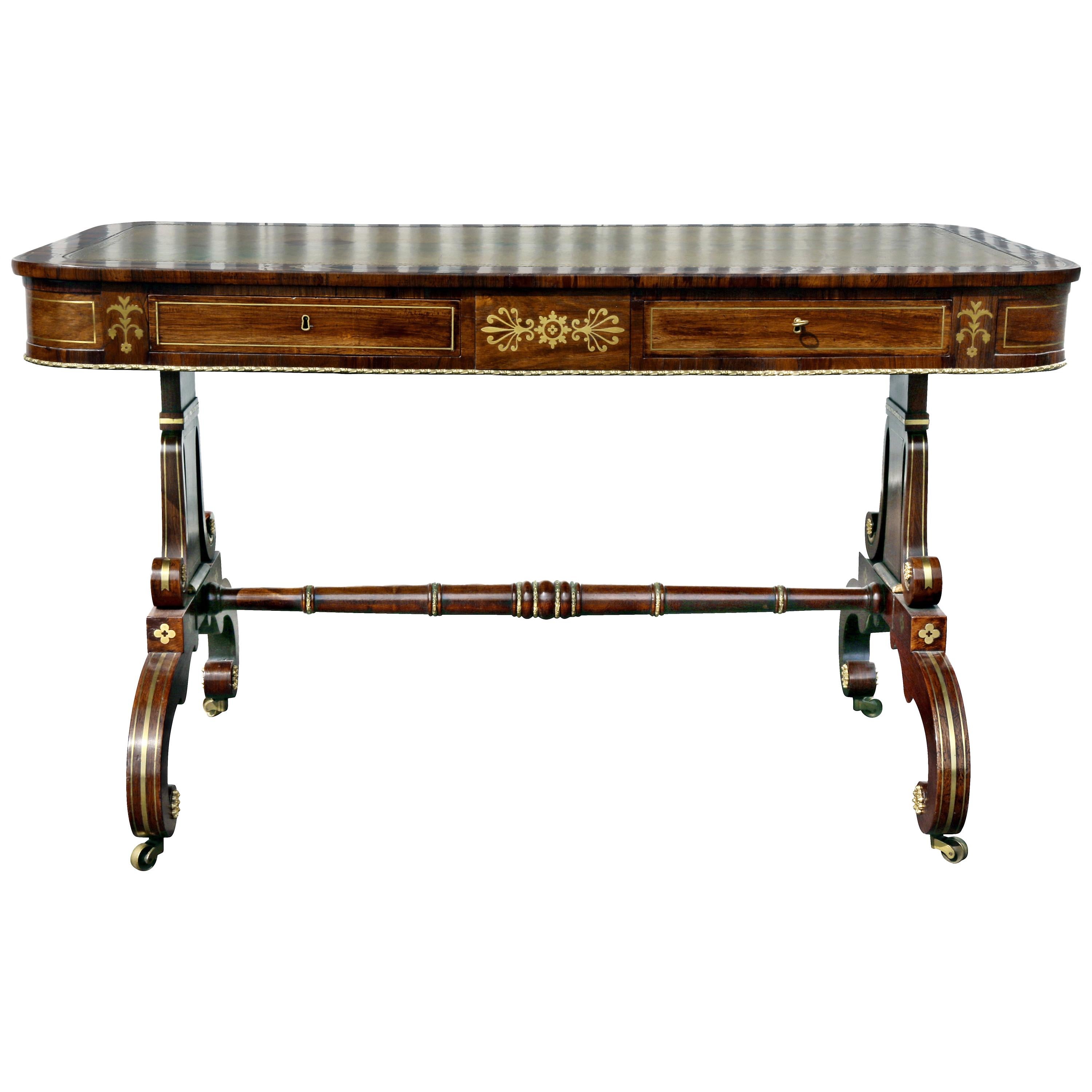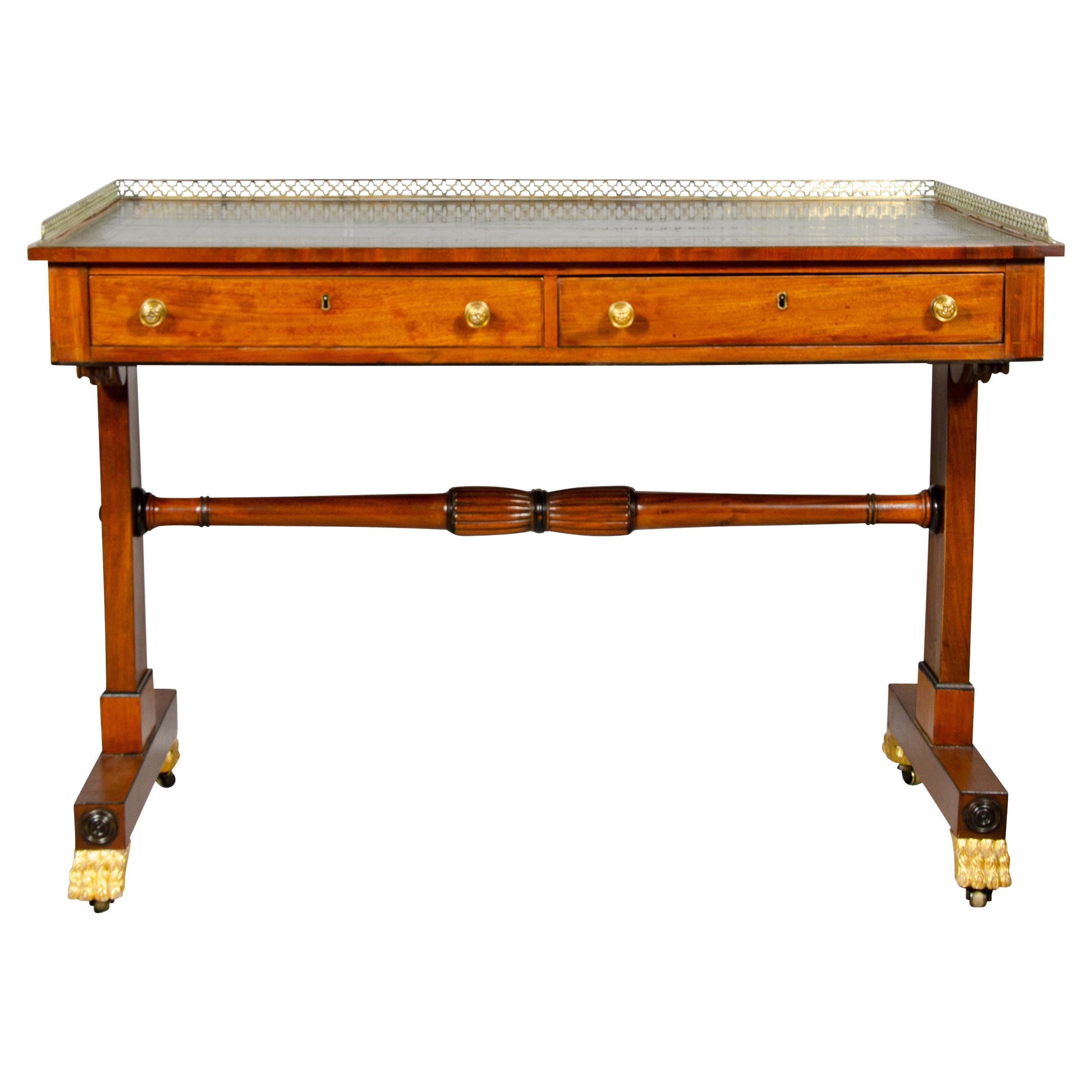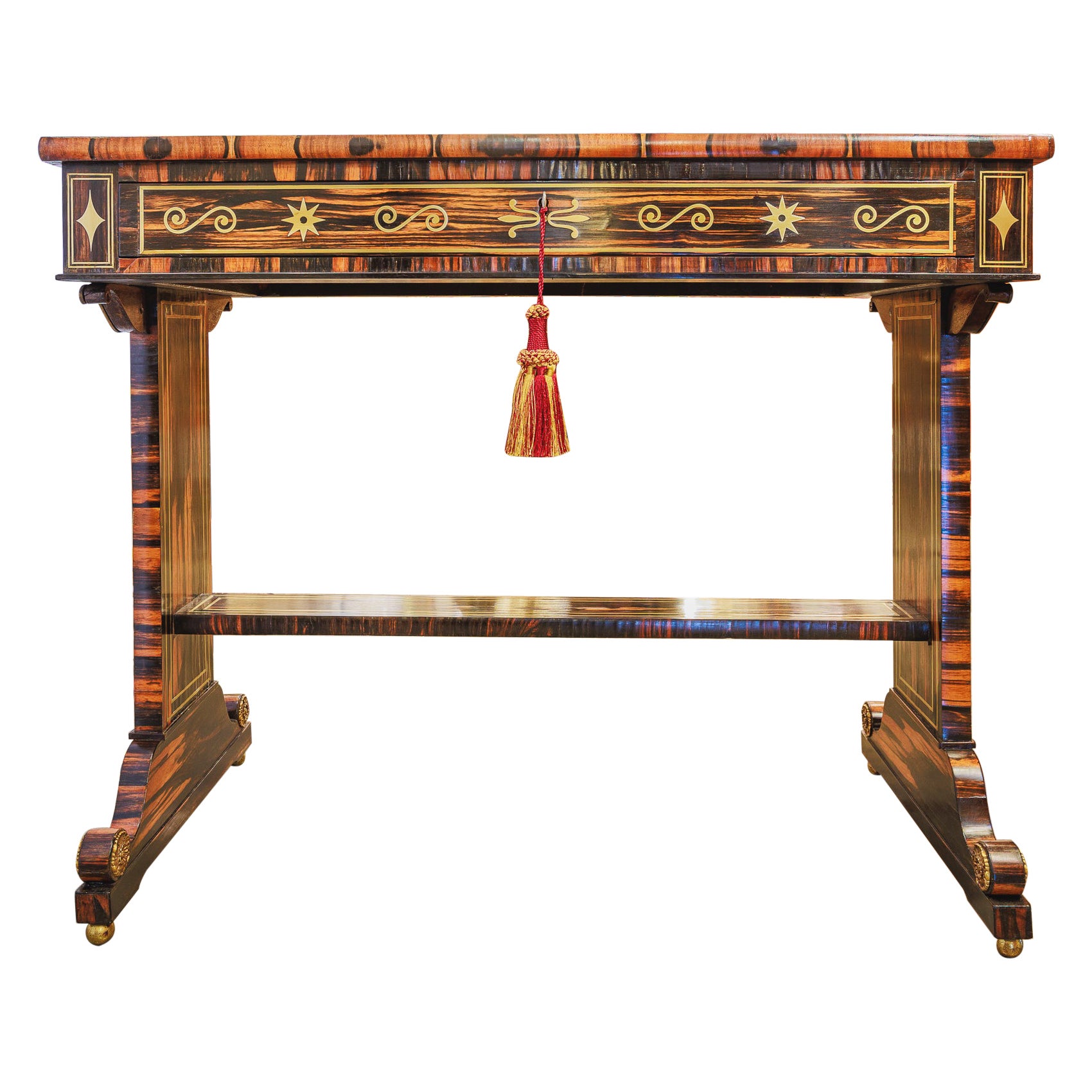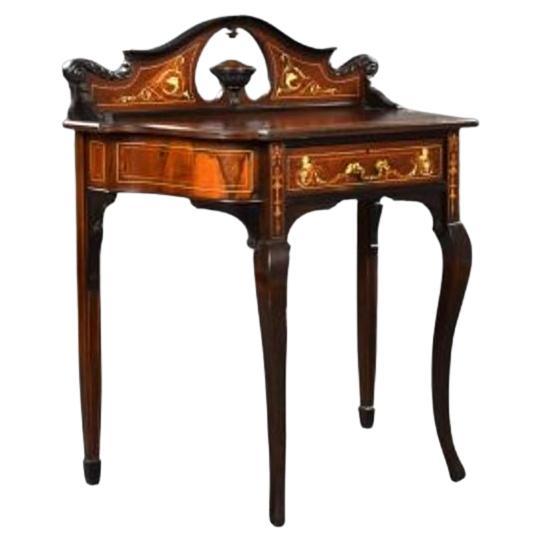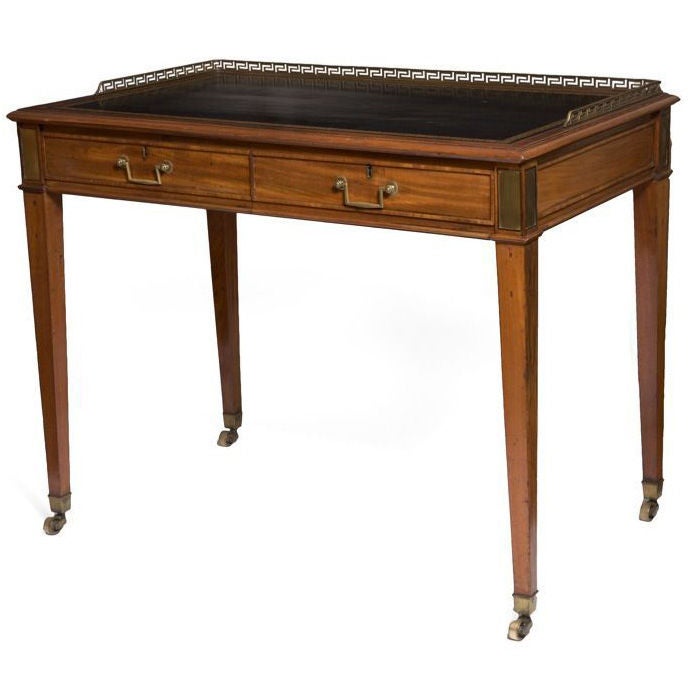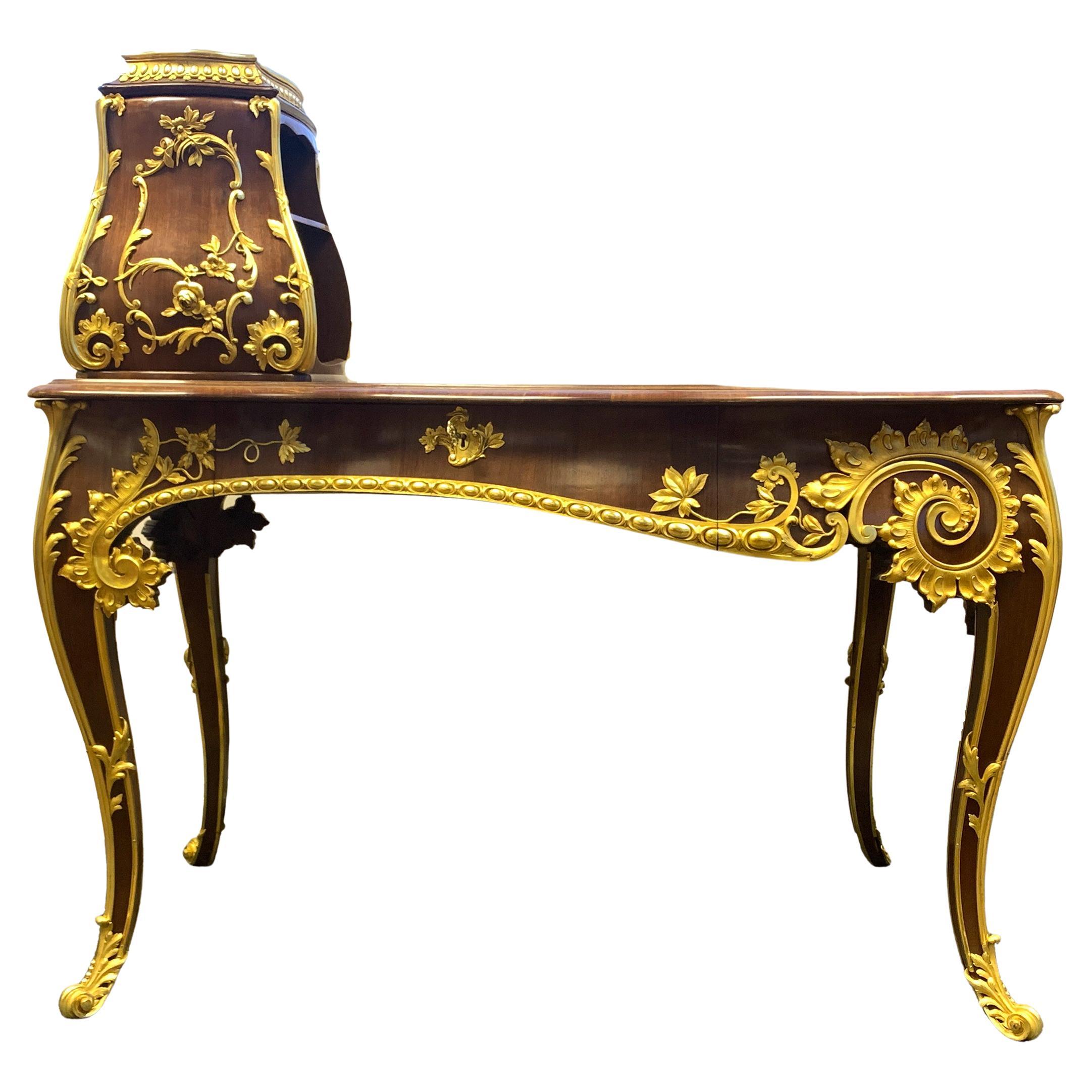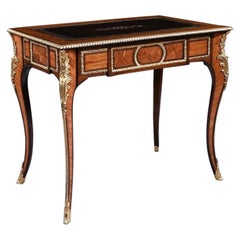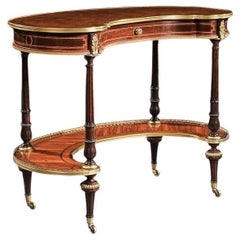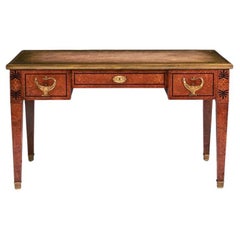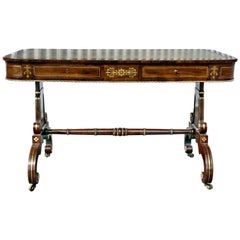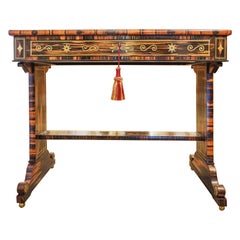Items Similar to An Extremely Fine Rosewood and Brass Inlaid Writing Table Attributed To Gillows
Want more images or videos?
Request additional images or videos from the seller
1 of 12
An Extremely Fine Rosewood and Brass Inlaid Writing Table Attributed To Gillows
$20,045.02
£15,000
€17,398.59
CA$28,253.95
A$31,028.32
CHF 16,203.57
MX$370,335.90
NOK 205,283.72
SEK 191,332.51
DKK 129,944.82
About the Item
An Extremely Fine and rare Rosewood and Brass Inlaid Writing Table Attributed to the Oxford Street Workshop of Gillows.
English c.1820-1830
With a raised back comprising a three quarter pierced anthemion brass gallery above a panelled front flanked by acanthus carved pilaster terminals, the interior with an arrangement of pigeonholes, a recess and small drawers with flame figured mahogany veneers, the lower part with a frieze drawer revealing tooled leather insets with an adjustable writing slope and compartments, raised on four turned and reeded tapering legs with acanthus carved knees.
Executed in the finest faded rosewood, this writing table is related to the earlier bonheur du jour or lady's writing table popularised by Thomas Sheraton. Adapted to suit regency fashion, the present piece is altogether more “masculine” in its proportions and design and favours carved detailing and brass inlay for is decorative effect.
Note : One for the connoisseur collector.
Gillows
There are several features of this piece that make a strong case for a Gillows attribution. The reeded bun feet are something of a trademark of the Gillows firm during this period and feature on many tables and side cabinets known to have been produced by the firm. The use of very neat pearled and beaded mouldings is also something that is encountered on many pieces made by the firm, as are the reeded and acanthus carved legs which are of very strong late regency form. It is, however, the complex brass inlay work which is the key to making the attribution. In her monograph on the Gillows firm Gillows of Lancaster and London, 1730-1840 Dr Susan Stuart illustrates a group of very fine furniture made c.1820-1830 which is by or firmly attributed to the firm and has brass inlay of similar conception and complexity. The monumental Hackwood Park writing table illustrated on p. 289 (plate 306) was known to have been supplied by the Oxford Street workshop to the 2nd Baron Boulton in 1813. The inlay used on the pilasters on this table is very similar in feeling to that on the pilasters on the superstructure on our table. However it is a large library table illustrated in plates 308-310, and also attributed to the Oxford Street workshops that is particularly relevant. Plate 309 shows a close-up of the inlay on the top of this table and the cartouche-type designs in the larger panels appear to be contre-partie versions of the premiere partie work on our table (contre-partie being Boulle work where the predominant decoration is in brass-thus dark on light-and premiere being the opposite with most of the decoration in wood or turtle shell as appropriate and the brass being the secondary part and thus light on dark). In other words, the panels appear to be taken from the same patterns and were almost certainly made in the same workshop.
Dr Stuart's book outlines various theories about the sources of brass inlay work on Gillows pieces, including suggesting that it might have been supplied by George Bullock, the major regency designer and cabinetmaker who specialised in inlay work of this sort. However the Hackwood suite, the library table and our piece seem to have more of a French style in the inlay work-something rather truer to the 17th century pieces produced by Andre Charles Boulle himself-and do not look like the sort of designs Bullock or his workshop would have created. Whoever did design and execute these wonderful panels of grotesques, somewhat in the style of the great 17th century designer Jean Berain, the workshop was every bit as capable as the Bullock one but with a very different aesthetic.
On page 290 of her book, Susan Stuart describes the differences between the two different centres of Gillow production. The surviving Gillows records are almost all concerned with the Lancaster workshop such as the large number of estimate sketch books in Westminster Archives but there are room setting drawings prepared for clients by the Oxford Street workshop which are in the collections of the Victoria and Albert Museum. Comparisons of the pieces illustrated by the Oxford Street workshops with those in the Lancaster estimate books of the same period is instructive. There are no glaring differences in quality between the pieces produced in the two different centres but there are clear differences in terms of fashionable taste. As would be expected, the Oxford Street workshop seems to have been, as Dr. Stuart puts it, “avante-garde” in the nature of the work that was produced there.
This object incorporates old ivory and has been registered with Defra
Ivory License Number 1K6ZWQXB
- Attributed to:Gillows of Lancaster & London (Maker)
- Dimensions:Height: 50.4 in (128 cm)Width: 44.1 in (112 cm)Depth: 23.04 in (58.5 cm)
- Materials and Techniques:
- Place of Origin:
- Period:
- Date of Manufacture:Circa 1820-1830
- Condition:Wear consistent with age and use.
- Seller Location:Benington, GB
- Reference Number:Seller: 30511stDibs: LU1183242764732
About the Seller
5.0
Gold Seller
Premium sellers maintaining a 4.3+ rating and 24-hour response times
Established in 1969
1stDibs seller since 2015
128 sales on 1stDibs
Typical response time: 1 hour
Associations
LAPADA - The Association of Arts & Antiques DealersThe British Antique Dealers' Association
- ShippingRetrieving quote...Shipping from: Benington, United Kingdom
- Return Policy
More From This Seller
View AllFrench 19th Century Gilt-Bronze Mounted Writing Table of Fine Quality
Located in Benington, Herts
An extremely fine 19th century French Louis XV Revival gilt ormolu mounted Kingwood bureau de dame / writing table.
French, circa 1870.
A very attractive and of the finest qua...
Category
Antique 19th Century French Desks and Writing Tables
Materials
Ormolu
Regency Amboyna and Brass Inlaid Gilt Bronze Mounted Pier Table
Located in Benington, Herts
An extremely elegant, rare Regency amboyna and brass inlaid gilt bronze mounted pier table. Provenance Part of Sir William Whitfield Collection.
English Regency period, Circa 1815.
The raised back with open shelf, surmounted by a pierced anthemion three quarter brass gallery above a rectangular mirror plate, flanked by gilt bronze pierced foliate scrolled supports, over a finely coloured amboyna and banded top above cut brass inlaid frieze drawer decorated with anthemion and flower head motif.
The dual tapering scroll supports with palmette lappet surmounts and cut brass inlay terminate on gilt bronze claw feet, flanking a later large mirror plate to the rear, raised on a inverted breakfront plinth base edged with gilt bonze beading. Formerly in the collection of Sir William Whitfield.
This elegant Regency pier table is a superb example with its fine quality mounts and distinctive amboyna veneers which are rarely found on furniture of this period.
The condition is excellent, having the most wonderful colour and patination to the finest cuts of amboyna that would have been available, during the early 19th century this veneer was thought to be worth more in its weight than gold.
This table would have almost certainly been especially commissioned, further research maybe undertaken to find a comparative example and insight to a potential maker.
As such pieces in amboyna are far rarer, an example of pier table has yet to be found, but an amboyna sofa table with extremely similar brass inlay and form can be seen in Clifford Musgrave’s book Regency Furniture, published by Faber and Faber in 1961, plate 63.
It is from the Royal Collection and the caption includes ‘made about 1816 for Clarement,’ (Claremont) ‘ Esher, Surrey, home of the Princess Charlotte...
Category
Antique 19th Century British Regency Vanities
Materials
Brass, Bronze
Fine 19th Century Gillows Parquetry and Gilt Bronze Kidney Shaped Table
By Gillows of Lancaster & London
Located in Benington, Herts
An extremely fine gilt bronze mounted parquetry kidney shaped writing table attributed to Gillows of Lancaster.
English Circa 1865
The rosewood lozenge trellis inlaid kidney shape...
Category
Antique 1860s English Desks
Materials
Bronze
Fine 19th Century French Neoclassical Style Amboyna and Gilt Bronze Mounted Writ
Located in Benington, Herts
An extremely fine and unusual French Amboyan and gilt bronze bureau plat - writing table inspired by the Neoclassical designs.
French circa 1880-1900.
A superb amboyna writing ...
Category
Antique 19th Century French Neoclassical Desks and Writing Tables
Materials
Bronze
Exceptional Early 17th Century Spanish Walnut Vargueno Desk on Stand
Located in Benington, Herts
An exceptionally fine example of an early 17th Century Spanish renaissance walnut vargueno / bargueno escritorio writing desk on trestle stand.
Sp...
Category
Antique 17th Century Spanish Renaissance Desks and Writing Tables
Materials
Walnut
Late 19th Century Mahogany Envelope Card Table by Antoine Lampre, Paris.
Located in Benington, Herts
A fine quality late 19th Century / early 20th Century envelope card table with ormolu mounts by Lampre of Paris
French Paris Circa 1900.
Of envelope form this card table is twiste...
Category
Early 20th Century French Card Tables and Tea Tables
Materials
Mahogany
You May Also Like
Regency Rosewood and Brass Inlaid Writing Table
Located in Essex, MA
With a rectangular green inset leather top with crossbanded brass inlaid edge over two drawers with brass inlays all around and false rear drawers raised on a trestle base with scrol...
Category
Antique Early 19th Century English Regency Desks and Writing Tables
Materials
Rosewood
Regency Mahogany And Inlaid Writing Table
Located in Essex, MA
Removed from the one time residence of William Randolph Hearst and Marion Davies Beverly Hills home. With rectangular top with 3/4 brass gallery and blac...
Category
Antique Early 19th Century English Regency Desks and Writing Tables
Materials
Mahogany
Fine and Rare 19th Century Regency Calamander and Brass Inlaid Writing Table
Located in Dallas, TX
A fine and rare English Regency Calamander and inlaid brass writing table . The finest brass inlay with Calamander wood . Single drawer.
Category
Antique Early 19th Century English Regency Desks and Writing Tables
Materials
Brass
Victorian Rosewood Inlaid Writing Table
Located in Chelmsford, Essex
For sale is a good quality Victorian rosewood inlaid ladies writing table, having a hand dyed leather hide writing surface, above a single drawer with ornate original brass handle, s...
Category
Antique 19th Century English Desks
Materials
Rosewood
George III Brass-Mounted Mahogany Writing Table
Located in Kittery Point, ME
In the French taste‚ the rectangular tooled leather inset writing surface with a three-quarter gallery‚ above two frieze drawers‚ with sham drawers to the reverse‚ raised on square t...
Category
Antique 18th Century and Earlier English George III Desks and Writing Ta...
Materials
Brass
Fine Antique 19th Century Wood and Bronze Inlaid Desk
Located in London, GB
Exquisite quality wood and bronze inlaid desk with shelfs.
Category
Antique 19th Century French Desks and Writing Tables
Materials
Bronze
More Ways To Browse
Leather Writing Slope
Ivory Inlaid
Antique Ivory Table
Two Drawer Sheraton Side Table
Antique Ivory Desk
Ivory Inlaid Table
Parsons Writing Desk
Paul Mccobb 1560
Pierre Chapo B40
Pierre Chapo Desk B40
Presidential Office Desk
Prouve Compass
Rectangular Library Tables
Regency Desk Bamboo
Regency Kidney Desk
Roll Top Desk American
Rosewood Partners Desk
Secretary Desk Chair
